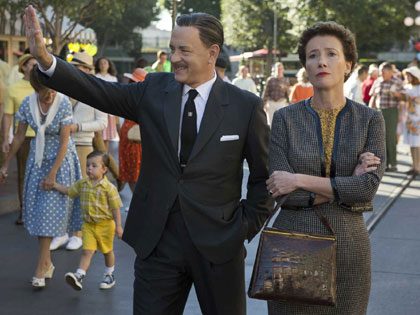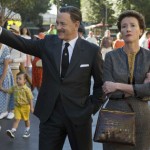Walt’s schmaltz, both old and new, is on display in the cute little period piece Saving Mr. Banks, which looks at a particularly bumpy stretch on the Disney-paved road to turning Mary Poppins into a cinematic classic. There’s a war over sentimentality being waged between Disney himself (a warm, welcoming Tom Hanks here) and Mary Poppins creator P.L. Travers (a comically cantankerous Emma Thompson), but while the back-and-forth battle suggests there’s room for give and take, it’s not hard to see where the movie’s allegiances lie. In the hands of director John Lee Hancock, sentimentality proves to be the only option, so the onscreen journey is essentially one of Travers loosening up a bit as Disney gets his way.
We know how the actual Mary Poppins picture turns out, of course, so when Travers insists that the movie adaptation not be a musical and that it be entirely live action, we know that plenty of budging on her part lies just around the corner. This lack of surprise isn’t really problematic, but the movie’s core message that there’s basically a sap in all of us is a little lightheaded when it’s probably meant to be lighthearted.
Hancock’s movie manages to paint a portrait of Disney-branded treacle that’s more strained and exaggerated than Walt’s actual use of feel-good, family-friendly drama. The heartstring tugging isn’t particularly poetic here and there’s a distinct lack of imagination in Hancock’s storytelling. And yet Saving Mr. Banks still exudes a warmth that’s sweetly inviting, which when accompanied by the very nice performances, actually makes for a rather pleasant experience.
The script by Kelly Marcel and Sue Smith births both good and bad elements, providing a nice dual timeline structure that wraps the main story in some mystery, but also struggling to prevent the earlier timeline from becoming overly predictable and redundantly sappy. The idea is that Travers is revisiting her childhood memories — those that inspired her to write the Mary Poppins books — while she fights to preserve her vision of the movie adaptation in early 60’s California.
We learn from the start that maintaining a truthful version of the character on her trip to the big screen is a matter of great importance to the financially strapped Travers. As the movie progresses, we gain an understanding of the backstory, the personal experiences that shaped the creation of the character and made her page-to-screen journey such a sensitive one for the author. The flashbacks peel back the layers so that our connection to Travers grows gradually and in unison with the Disney employees who initially struggle to meet her many demands.
It’s a decent idea to use the flashbacks to slowly reveal the truth of what Mary Poppins means to Travers and what is ultimately most important to her in terms of the adaptation that we know Disney and company are going to turn into a beloved classic, but there’s still the unavoidable issue of treacle. Since Travers is so steadfastly against the ghastly crime of sentimentalizing her material that she’s sure Disney will commit, it’s tough to accept that she daydreams in such syrupy tones.
The flashbacks are fine fluff at first, with Annie Rose Buckley as a young version of the author and Colin Farrell as her playfully inspiring father, who sadly happens to double as an alcoholic. One can only imagine how much room for sentimentality there exists when alcoholism is tossed into the mix of a family film. Hancock really runs with it after a while, too, employing slow motion shots to capitalize on the maximum amount of tawdry tear-jerking. Mary Poppins’ spoonful of sugar is delivered by the truckload here.
Knowing that Travers, in the context of this movie, is an even bigger sap deep down than the one she accuses Disney of being feels somewhat counter-productive considering the core conflict of Saving Mr. Banks. But while these issues remain significant, the contributions of Hanks and Thompson at least offer some balance. Hanks is wonderful as the larger-than-life icon with a twinkle in his eye. He brings a relatable sensibility to the guy that keeps his feet on the ground, while also maintaining a sparkling, charming presence that suggests a legend who is proud of his status. Thompson gets to be the prickly epicenter of the whole movie and she prevents Travers from ever devolving into a cheaply etched stereotype, so her eventual lightening of spirit, while a bit of a rushed convenience in the script, feels convincing on a purely human level.
Hancock’s own positive contributions include his ability to cozily resurrect a bygone era of Hollywood wheeling and dealing. The exquisite production design for Saving Mr. Banks lovingly recreates the 60s setting of a sun-soaked studio lot in Burbank and Hancock captures a sweet sense of nostalgia for a man and his studio that put an indelible mark on the entertainment world. A scene involving a trip to Disneyland is shot at the actual park, while still maintaining the period feel. It’s all an obvious illusion, but a cute and cuddly one that’s relatively easy to buy into. The war of sentimentality never really feels like a fair fight, though. In Hancock’s world, you can never have enough sugar. That ol’ iconic spoonful is a modest measurement in comparison.






'Movie Review: Saving Mr. Banks (2013)' has no comments